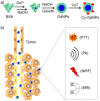Strategies for Preparing Albumin-based Nanoparticles for Multifunctional Bioimaging and Drug Delivery
- PMID: 29109768
- PMCID: PMC5667340
- DOI: 10.7150/thno.19365
Strategies for Preparing Albumin-based Nanoparticles for Multifunctional Bioimaging and Drug Delivery
Abstract
Biosafety is the primary concern in clinical translation of nanomedicine. As an intrinsic ingredient of human blood without immunogenicity and encouraged by its successful clinical application in Abraxane, albumin has been regarded as a promising material to produce nanoparticles for bioimaging and drug delivery. The strategies for synthesizing albumin-based nanoparticles could be generally categorized into five classes: template, nanocarrier, scaffold, stabilizer and albumin-polymer conjugate. This review introduces approaches utilizing albumin in the preparation of nanoparticles and thereby provides scientists with knowledge of goal-driven design on albumin-based nanomedicine.
Keywords: Albumin; Bioimaging; Drug delivery; Multifunctional.; Nanoparticle; Theranostics.
Conflict of interest statement
Competing Interests: The authors have declared that no competing interest exists.
Figures









References
-
- Lee D-E, Koo H, Sun I-C. et al. Multifunctional nanoparticles for multimodal imaging and theragnosis. Chem Soc Rev. 2012;41:2656–72. - PubMed
-
- Su J, Sun H, Meng Q. et al. Long Circulation Red-Blood-Cell-Mimetic Nanoparticles with Peptide-Enhanced Tumor Penetration for Simultaneously Inhibiting Growth and Lung Metastasis of Breast Cancer. Adv Funct Mater. 2016;26:1243–52.
-
- Anselmo AC, Zhang M, Kumar S. et al. Elasticity of nanoparticles influences their blood circulation, phagocytosis, endocytosis, and targeting. ACS Nano. 2015;9:3169–77. - PubMed
Publication types
MeSH terms
Substances
LinkOut - more resources
Full Text Sources
Other Literature Sources
Research Materials

